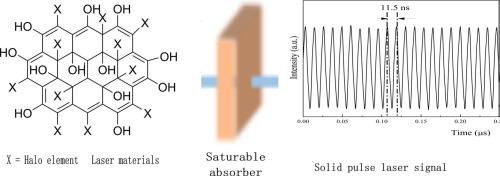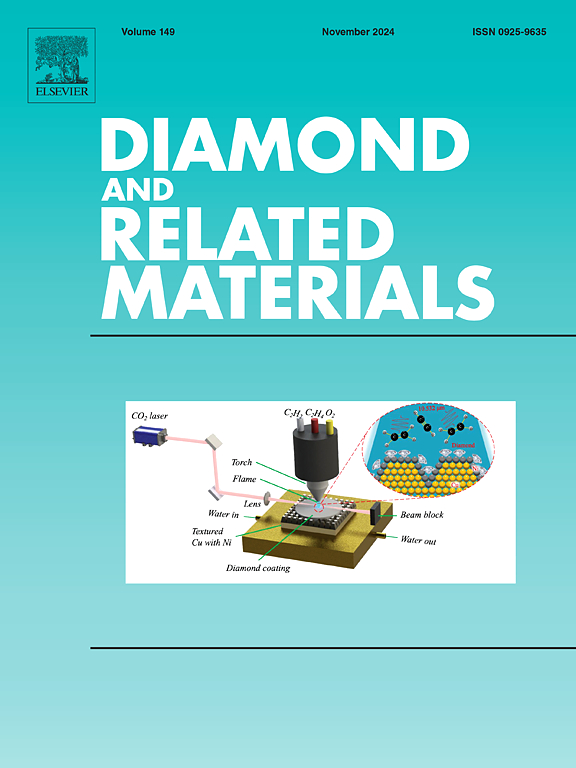Syntheses of stable and hydrophilic large-size halogenated graphene oxide-like materials for studying effects of halogenation on their electrochemical and optical properties
IF 4.3
3区 材料科学
Q2 MATERIALS SCIENCE, COATINGS & FILMS
引用次数: 0
Abstract
Graphene derivatives has popularly applied in electron, laser, etc. Pulse laser devices need excellent graphene oxide derivatives, which should be easily made into stable films in air for fabricating high-performance laser devices. In this paper, stable and hydrophilic halogenated graphene oxide-like with hydroxyl groups (GOLH) materials were synthesized to study their electrochemical properties and application in solid pulse laser devices. Experimental results showed that the highest occupied molecular orbital energy level (EHOMO) and the lowest unoccupied molecular orbital energy level (ELUMO) values of three halogenated materials were 0.09–0.27 eV and 0.08–0.12 eV lower than those of GOLH, respectively. The mothed of Cl atoms replacing hydroxyl groups on the surfaces of GOLH can be applied in tuning the energy band gap (Eg) of graphene oxide derivatives. Halo elements partly substituting the hydroxyl groups on the surface of GOLH elongated insignificantly pulse duration of the signals of solid pulse lasers. Therefore, halo elements partly substituting the hydroxyl groups on the surface of GO derivatives would be a useful method of improving electrochemical stabilities of GO derivatives, tuning EHOMO, ELUMO and Eg of GO derivatives and preparing good optical materials for fabricating solid pulse lasers with stable signal intensity and narrow pulse duration.

合成稳定的亲水性大尺寸卤化氧化石墨烯类材料,用于研究卤化对其电化学和光学特性的影响
石墨烯衍生物已广泛应用于电子、激光等领域。脉冲激光设备需要性能优异的氧化石墨烯衍生物,这种衍生物应易于在空气中制成稳定的薄膜,以制造高性能的激光设备。本文合成了稳定的带羟基的亲水卤代氧化石墨烯(GOLH)材料,研究其电化学性质及在固体脉冲激光器件中的应用。实验结果表明,三种卤化材料的最高占有分子轨道能级(EHOMO)和最低未占有分子轨道能级(ELUMO)值分别比 GOLH 低 0.09-0.27 eV 和 0.08-0.12 eV。用 Cl 原子取代 GOLH 表面的羟基可用于调节氧化石墨烯衍生物的能带隙(Eg)。部分取代 GOLH 表面羟基的光环元素显著延长了固体脉冲激光器信号的脉冲持续时间。因此,部分取代石墨烯衍生物表面羟基的光环元素将是一种有效的方法,可以提高石墨烯衍生物的电化学稳定性,调节石墨烯衍生物的 EHOMO、ELUMO 和 Eg,并制备出良好的光学材料,用于制造具有稳定信号强度和较窄脉冲持续时间的固体脉冲激光器。
本文章由计算机程序翻译,如有差异,请以英文原文为准。
求助全文
约1分钟内获得全文
求助全文
来源期刊

Diamond and Related Materials
工程技术-材料科学:综合
CiteScore
6.00
自引率
14.60%
发文量
702
审稿时长
2.1 months
期刊介绍:
DRM is a leading international journal that publishes new fundamental and applied research on all forms of diamond, the integration of diamond with other advanced materials and development of technologies exploiting diamond. The synthesis, characterization and processing of single crystal diamond, polycrystalline films, nanodiamond powders and heterostructures with other advanced materials are encouraged topics for technical and review articles. In addition to diamond, the journal publishes manuscripts on the synthesis, characterization and application of other related materials including diamond-like carbons, carbon nanotubes, graphene, and boron and carbon nitrides. Articles are sought on the chemical functionalization of diamond and related materials as well as their use in electrochemistry, energy storage and conversion, chemical and biological sensing, imaging, thermal management, photonic and quantum applications, electron emission and electronic devices.
The International Conference on Diamond and Carbon Materials has evolved into the largest and most well attended forum in the field of diamond, providing a forum to showcase the latest results in the science and technology of diamond and other carbon materials such as carbon nanotubes, graphene, and diamond-like carbon. Run annually in association with Diamond and Related Materials the conference provides junior and established researchers the opportunity to exchange the latest results ranging from fundamental physical and chemical concepts to applied research focusing on the next generation carbon-based devices.
 求助内容:
求助内容: 应助结果提醒方式:
应助结果提醒方式:


